Historical Eclipses
Reliable records of solar and lunar eclipses go back
as far as 750 B. C. They bear on such questions as whether the sun is shrinking
or the earth is not spinning as fast as it once did
by F. Richard Stephenson
Scientific American - 1982. - 247, N4. - 154-163
Observers on our planet?astronomers, historians and even poets?have
been recording eclipses of the sun and the moon for more than 2,500 years.
Whatever their motivation, their records, both ancient and more recent,
can help to answer questions that challenge investigators today. One such
question is: Why is the length of the day (or the earth's rate of rotation)
changing? Another is: Is the sun shrinking? On the first question eclipse
observations long before the rise of telescopic astronomy have provided
information of much value. On the second only the records of total solar
eclipses since the 18th century are pertinent.
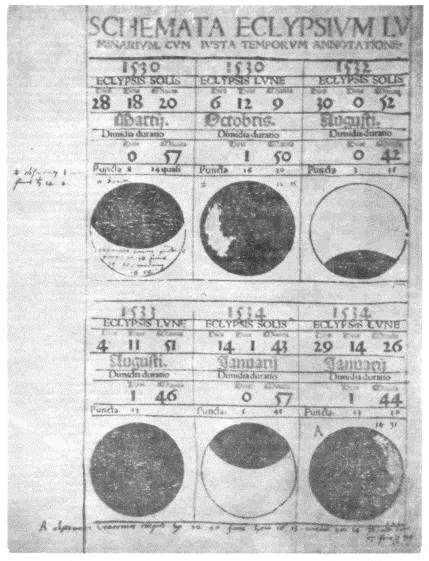
THREE PARTIAL SOLAR ECLIPSES (in 1530, 1532 and 1534) and
three total lunar eclipses are predicted on this page of Calaulariurn Romanum
Magnum, published in 1518. The author, Johann Stoffler of Tubingen, was
a prominent Renaissance astronomer-mathematician. The handwriting in this
copy of Stoffler's work, now in the library of the University of Uppsala,
is that of Nicolaus Copernicus.
We owe the term "eclipse" to the ancient Greeks: ekleipsis
means "failure," in the sense of something gone wrong. The image is apt,
and if the orbits of the earth and the moon were in exactly the same plane,
these failures would be far more frequent: two per month. At each conjunction,
or new moon, the sun would be eclipsed; at each opposition, or full moon,
the moon would be eclipsed. Actually, since the orbital planes are tilted
with respect to each other by some five degrees, eclipses can come only
when the new or full moon happens to be near one of the two "nodes" of
its orbit. These are the points, 180 degrees apart, where the plane of
the moon's orbit intersects the plane of the earth's. This limitation means
that any one year may have as few as two eclipses (the number in 1984)
or as many as seven (the number this year).
Weather permitting, a man in his lifetime might expect to see some 50
lunar eclipses, more than half of them total, and perhaps 30 partial solar
eclipses. A total eclipse of the sun, however, is a rare event at any one
location. For example, the last total solar eclipse visible in the
vicinity of New York City was in 1925 and the next will not be until 2079.
What makes the spectacle so rare is that the sizes of the sun and the moon
in the sky are almost identical, and as a result the conical shadow cast
by the moon barely reaches the surface of the earth. The path of totality
may be some 15,000 kilometers long, sweeping across as much as 140 degrees
of longitude, but the umbra, or region of dark shadow, is seldom more than
250 kilometers wide.
Whether a given solar eclipse is total or annular (with a bright ring
of sun surrounding the disk of the moon) depends on the position of the
moon in its elliptical orbit. When the moon is near perigee, its point
of closest approach to the earth, it is able to cover the sun completely
for as long as 7.5 minutes. When the moon is near apogee, its point of
most distant recession, its shadow falls considerably short of the earth
and the eclipse is annular. The duration of an annular eclipse can be as
long as 12.5 minutes. Astronomers call total, annular and near-total eclipses
of the sun large events, as opposed to the smaller events of partial eclipses.
Is the sun really shrinking? Two large bodies of data bearing on the
subject are the daily observations, weather permitting, of the transit
of the sun (in order to measure its right ascension) at the Royal Observatory
in Britain since 1750 and at the U.S. Naval Observatory in Washington since
1846. The observations include the time required for the sun's image to
pass a wire fixed in the eyepiece of a telescope; the interval, of course,
also measures the size of the image. In 1979, after analyzing substantial
amounts of the data from both observatories, John A. Eddy of the High Altitude
Observatory of the National Center for Atmospheric Research and Aram A.
Boornazian, a mathematician at S. Ross and Company in Boston, announced
their conclusion that the sun is indeed shrinking, and at a considerable
rate. They estimated the shrinkage of the sun's horizontal diameter to
be about two seconds of arc, or about .1 percent, per century.
The sun's disk is brilliant, however, and the transparency of the earth's
atmosphere is both imperfect and variable; these factors make accurate
determination of the solar diameter by this kind of observation difficult.
It is therefore not surprising that individual transit observations are
less than precise and are also subject to considerable observer bias. As
a result at least part of the trend detected by Eddy and Boornazian could
actually be an artifact of observational error. An alternative and independent
source of data regarding solar shrinkage is the duration of total solar
eclipses. (A second independent check is provided by the time the planet
Mercury takes to cross the solar disk.) Such observations allow a monitoring
of changes in the sun's diameter at fairly regular intervals back to about
the start of the 18th century, or roughly twice the span of time covered
by the British and American transit data analyzed by Eddy and Boornazian.
Few total solar eclipses were visible in Europe in the 17th century.
I know of only two observations: one made in southern Italy in 1605 and
one made in northern Ireland in 1652. Indeed, the first known telescopic
observation of a total solar eclipse was made in France in 1706. The first
total solar eclipse to be carefully timed by a substantial number of observers
in Europe was the eclipse of 1715, which was on May 3 (according to the
Gregorian calendar). Most of the credit for this effort goes to Edmund
Halley. Well before the event he "caused a small map of England,
describing the Track and Bounds [of the eclipse], to be dispersed all over
the Kingdom, with a Request to the Curious to observe what they could about
it, but more especially to note the time of total Darkness, as requiring
no other instrument than a Pendulum Clock with which most Persons
are furnish'd, and as being determinable with the utmost Exactness, by
reason of the momentaneous [sic] Occultation and Emersion of 'the luminous
Edge of the Sun, whose least part makes Day."
Halley's motive in promoting the timing experiment was to improve the
accuracy of future eclipse predictions. He harvested nine ostensibly accurate
measurements from various parts of Britain. The duration of totality (about
3.3 minutes) was expressed to the nearest second of time; all but one of
the nine measurements showed a small scatter, not much greater than the
rounding error. Even the one discordant observation deviated by only seven
seconds from the 200-second mean of the other eight, hardly a bad result.
Converting the average of the eight into a measurement of the sun's diameter
as it is now standardized, the sun in 1715 was smaller than it is today
by two-tenths of a second of arc (with a probable error of four-tenths
of a second).
The next total solar eclipse after the one of 1715 that was carefully
timed came more than 125 years later. From 1842 until early in this century,
however, most total eclipses were accurately timed, and astronomers often
traveled to remote places to observe them. After 1925 the focus of eclipse
observation shifted, to the neglect of totality timing, to such topics
as the identification of lilies in the solar spectrum and the study of
the structure of the solar corona. Only lately has the topic of timing,
with the specific objective of measuring the diameter of the sun, regained
its place. Much of the credit must go to Eddy and Qoornazian.
When the times of total solar eclipses over the past three centuries
or so are analyzed in conjunction with the data on the transits, of Mercury,
they suggest a conclusion contrary to the one based on solar right-ascension
observations. In brief, the data indicate only a negligible change in the
sun's diameter. John H. Parkinson of University College London, Leslie
V. Morrison of the Royal Greenwich Observatory and I have calculated that
the percentage of decrease is .008 ± .007 per century. Surprisingly,
however, the data provide fairly strong evidence that the diameter of the
sun oscillates. The period of the oscillation is some 80 years and its
amplitude is about .025 percent. After investigating a wide variety of
data Ronald L. Gilliland of the High Altitude Observatory supports this
interpretation. In any event measurement of the sun's diameter on a regular
basis seems worth pursuing in the future.
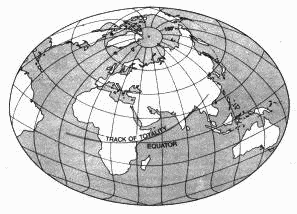
TOTAL ECLIPSE OF THE SUN in 1980 was visible on February
16 along a track no more than 150 kilometers wide that ran from west of
the prime meridian to western China, a distance of 13,500 kilometers. It
was visible mainly at sea and totality lasted for only about four minutes.

INNER PART of the sun's corona, normally invisible, rings
the circumference of the moon in this photograph of the eclipse of February
16, 1980. Flecks of color are solar prominences;
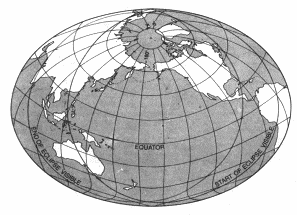
TOTAL ECLIPSE OF THE MOON at the end of 1982 will also be
visible mainly at sea, but if weather permits, it may be seen from start
(black ellipse) to finish (colored ellipse) in Iceland, Greenland, all
of Canada except eastern Newfoundland, all 50 states of the U.S., aU of
Mexico, all of Japan and Korea, much of the eastern and arctic U.S.S.R.,
most of the Philippines, parts of Indonesia and Australia and all of New
Zealand during the night of December 30-31.

TWO COMPONENTS of the earth's shadow appear in this photograph
of the total lunar eclipse of January 9,1982, as totality was advancing.
What appears to be a crescent missing from the moon's edge is the unibral
sector; the lighter band beyond is the deep penumbra) sector.
When it comes to the variations in the earth's rate of rotation,
only eclipse data from ancient and medieval times are of value. From about
1620 onward telescopic observations of the occultation of stars by the
moon have replaced observations of solar and lunar eclipses as a source
of information on the length of the day. The reason is that the occultation
of a star is almost instantaneous. Among eclipses only total solar obscurations
can be timed with comparable precision, and they are much rarer than occultations.
The study -of star occultations has revealed irregular fluctuations
in day length over periods on the order of a decade, hence the term "decade
fluctuations." The fluctuations themselves are quite small, no more than
two or three milliseconds above or below the average, but their cumulative
effect is fairly large. For example, if the length of the day remained
continuously about three milliseconds above the average for a full decade,
the accumulated total of what is called clock error (the difference between
a clock keeping earth time and an "ideal" clock) would be about 10 seconds.
Morrison and I have used the occultation data to map the decade fluctuations
in detail from the 17th century to the present.
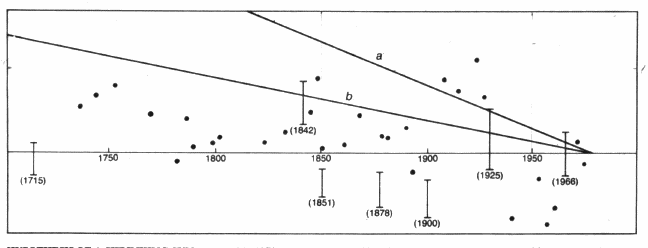
HYPOTHESIS OF A SHRINKING SUN, proposed in 1979 following
analysis of thousands of right-ascension measurements, is contradicted
by measurements based on the observed duration of 30 transits of Mercury
{colored dots) and six total solar eclipses from a.d. 1715 to 1925. The
two slopes indicate where past measurements of the sun's diameter should
have fallen if indeed it has been shrinking at a rate of one second of
arc per century (a) or at half that rate (*). Typically each of the eclipses
from 1715 to 1925 has been timed by some 10 to 20 observers and the transits
of Mercury often by more than 100 observers. The means of the eclipse measurements
are entered for the appropriate year, the error bars represent a 95 percent
level of confidence. Analysis of both series of observations supports the
conclusion that the sun's apparent diameter is changing at a rate of minus
.16 ± .14 second of arc per century, essentially a null result.
Substantial variations are evident, however, implying that on a time scale
of decades fluctuations in the diameter of the sun do take place.
How can these fluctuations be explained? One hypothesis suggests that
fluid motions in the core of the earth, which are responsible for the earth's
magnetic field, are coupled, electromagnetically or possibly topographically,
with the surrounding mantle and disturb the rotation of the mantle. Such
disturbances would then be communicated to the earth's surface. Another
hypothesis points out that small changes in the global sea level, produced
by the melting or freezing of polar ice, would alter the planet's moment
of inertia and so affect its rate of rotation.
For all their relative imprecision ancient and medieval eclipse data
are nonetheless valuable for a second kind of study: the long-term changes
in the earth's rate of rotation. These changes are masked in recent centuries
by the short-term changes described above. For example, it has long been
realized that the tides of the earth's oceans, the product of lunar (and
to a lesser extent solar) gravitational influences, have a braking effect
that is responsible for a gradual increase in the length of the day. The
moon's tidal influences can be readily estimated today because of modern
studies of the moon's motions, such as lunar laser ranging. These studies
show that the orbit of the moon is slowly getting larger, so that our satellite
is receding from its planet at a rate of about four centimeters per year.
The two phenomena are interrelated. As the earth's rotation slows, the
planet loses angular momentum. The angular momentum of the earth-moon system,
however, is conserved, and so what the earth loses the moon gains. An orbiting
satellite that gains angular momentum actually loses speed and so recedes
from its planet; this is what the moon is doing. Calculations indicate
that the tidal gain in the moon's angular momentum adds about .04 second
to the length of the month each century.
Like the decade fluctuation, such a small change seems a trifling matter.
Its long-term effects are nonetheless important. For example, let it be
assumed that tidal friction has been the same for many millions of years.
Then 100 million years ago, in mid-Cretaceous times, the mean distance
between the earth and the moon would have been 4,000 kilometers less than
it is at present, and each month would have been shorter by somewhat more
than 11 hours.
How can the record of ancient and medieval eclipses yield useful data
on a gradual slowing of the earth? Consider clock error. Over a span of
100 years, the clock keeping earth time would lose some 45 seconds compared
with the ideal clock, because of the effect of tides on the earth's rotation.
What is more, over still longer periods the clock error increases as the
square of the elapsed time. For example, 1,000 years ago the expected accumulated
clock error due to tides would have been an hour and a quarter, and 2,000
years ago it would have been five hours. Since at least some eclipse records
are well over 2,000 years old, if certain facts about the observation can
be established, the record can provide significant information on trends
in the earth's of rotation.
| YEAR |
DAY |
LOCATION |
DESCRIPTION |
| B.C. 709 |
JULY 17 |
CHINA |
TOTAL: NO OTHER DETAILS |
| 601 |
SEPT. 12 |
CHINA |
TOTAL: NO OTHER DETAILS |
| 549 |
JUNE 12 |
CHINA |
TOTAL: NO OTHER DETAILS |
| 198 |
AUG. 7 |
CHINA |
ANNULAR: NO OTHER
DETAILS |
| 181 |
MAR. 4 |
CHINA |
TOTAL: NO OTHER DETAILS |
| 136 |
APR.15 |
MESOPOTAMIA |
TOTAL: MANY STARS
AND FOUR PLANETS SEEN |
| A.D. 2 |
NOV. 23 |
CHINA |
TOTAL: NO OTHER DETAILS |
| 65 |
DEC.16 |
CHINA |
TOTAL: NO OTHER DETAILS |
| 516 |
APR. 18 |
CHINA |
ANNULAR: NO OTHER
DETAILS |
| 522 |
JUNE 10 |
CHINA |
TOTAL: NO OTHER DETAILS |
| 840 |
MAY 5 |
ITALY |
TOTAL: "SUN HIDDEN
FROM WORLD" |
| 873 |
JULY 28 |
PERSIA |
ANNULAR: "MOON WITHIN
BODY OF SUN" |
| 912 |
JUNE 17 |
SPAIN |
TOTAL: "DARKNESS JUST
BEFORE SUNSET" |
| 968 |
DEC.22 |
TURKEY (2) |
TOTAL: CORONA OBSERVED |
| 975 |
AUG.10 |
JAPAN |
TOTAL: "INK-COLORED
SUN" |
| 1124 |
AUG.11 |
RUSSIA |
TOTAL: "SUN PERISHED
COMPLETELY" |
| 1133 |
AUG. 2 |
EUROPE (5) |
TOTAL: "SUN BLACK
AS PITCH" |
| 1176 |
APR.11 |
TURKEY |
TOTAL: "NIGHT FELL,
STARS APPEARED" |
| 1185 |
MAY 1 |
RUSSIA |
TOTAL: CHROMOSPHERE
OBSERVED |
| 1221 |
MAY 23 |
MONGOLIA |
TOTAL: "STARS VISIBLE" |
| 1239 |
JUNE 3 |
EUROPE (8) |
TOTAL: "MANY STARS
SEEN" |
| 1241 |
OCT. 6 |
EUROPE (2) EGYPT |
TOTAL: "WONDERFUL
BLACKNESS" |
| 1267 |
MAY 25 |
TURKEY |
TOTAL: "MANY STARS
APPEARED" |
| 1275 |
JUNE 25 |
CHINA |
TOTAL: "STARS SEEN" |
| 1292 |
JAN.21 |
CHINA |
ANNULAR: "SUN A GOLDEN
RING" |
| 1406 |
JUNE 16 |
GERMANY |
TOTAL: "GREAT DARKNESS" |
| 1415 |
JUNE 7 |
EUROPE (2) |
TOTAL: "ENTIRE SUN
ECLIPSED" |
| 1485 |
MAR. 16 |
AUSTRIA |
TOTAL: NO OTHER DETAILS |
TWENTY-EIGHT SOLAR ECLIPSES, either total or annular,
are noted in records from eighth century B.C. through the 15th century
A.D. All but one of the 10 most ancient eclipses listed in this table were
observed by Chinese astronomers. The later predominance of Euro eclipse
observers is due to the rise of monastic communities. Multiple sightings
are numbered.
Before presenting the conclusions that can be drawn from such records
it will be helpful to indicate what criteria the early observations must
satisfy and to give an abbreviated account of the observations area by
area. For early observation to be of value it must fall into one of three
categories. The first category consists of the most valuable observations:
timed solar and lunar eclipses. The second consists of solar and lunar
eclipses that are untimed but are reported as having come near sunrise
or sunset. The third consists of solar eclipses that are untimed but are
reported as large events: near-total or total.
As for the areas in which the observations were made, they begin with
Babylonia. At least as early as 750 b.c. Babylonian astronomers began to
take an active interest in the accurate observation of many celestial phenomena,
including solar and lunar eclipses. We cannot say how much earlier observations
may have been made in Babylonia or anywhere else simply because there is
little by way of historical records from more ancient times. Systematic
Babylonian observations continued from about 750 b.c. to at least 50 b.c.
and possibly well into the first century a.d. This large corpus of astronomical
data was well known to the ancient Greeks. The Greek astronomer Ptolemy
of Alexandria, writing early in the second century a.d., claimed access
to Babylonian eclipse observations going back to 747 b.c. It is a cause
for regret that Ptolemy, in his Mathematike Syntaxis (better known
today by its Arabic name, Almagest), gives only brief extracts from
the Babylonian record.
After about 300 b.c. Babylonia gradually decayed, and by a.d. 100 the
city of Babylon was deserted. More than 1,700 years were to pass before
the Babylonian astronomical tablets again came to light, accidentally unearthed
by scavengers digging up the ancient baked clay bricks of the city to use
in new construction. Most of the surviving astronomical tablets, many in
fragmentary condition, are now in the British Museum. What was salvaged
represents only some 5 percent of the original archive, and much of it
is undatable. Only future excavation will determine whether more of the
tablets remain to be found.
The traditional Babylonian practice was to measure the interval between
the start of an eclipse and either sunrise or sunset with the aid of a
water clock; the durations of the various phases were also usually measured.
Time was expressed in units called us, the four-minute interval
required for the celestial sphere to turn through one degree. It was also
the Babylonian practice to estimate the degree of totality of an eclipse
as a fraction of the solar or lunar diameter. Finally, if the sun or the
moon rose or set while the eclipse was in progress, that fact was usually
noted.
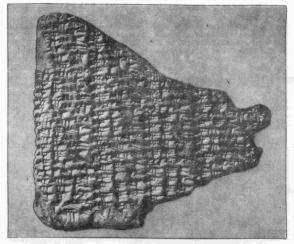
EARLIEST SOLAR ECLIPSE for which the date is certain is
recorded on this Assyrian tablet, a summary of past historical events.
A large partial eclipse, it took place on June 15, 763 b.c.
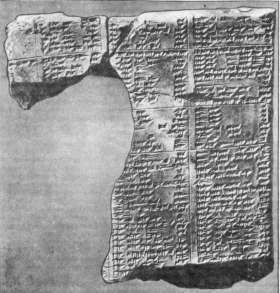
LATE BABYLONIAN TABLET records new- and full-moon observations
made between 323 and 319 b.c. Like the Assyrian tablet, it is among the
ancient texts in the British Museum.
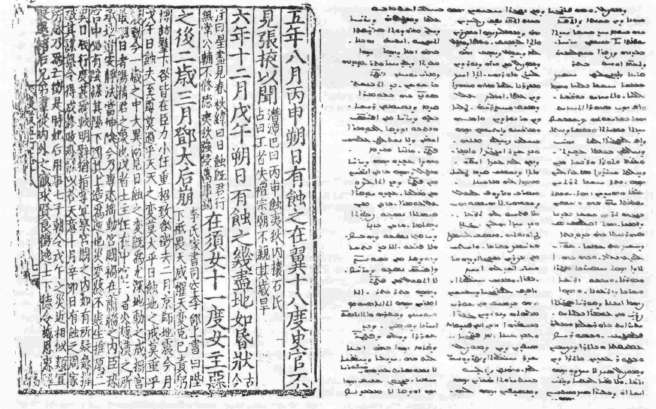
TWO HISTORICAL TEXTS that include references to eclipses
of the sun are the official history of the Eastern Han dynasty (left) and
the Chronicle of the Patriarch of Antioch, Michael the Syrian (right).
The Chinese text describes solar eclipses of a.d. 118 and 120, the latter
regarded as presaging the empress dowager's death in a.d. 122. The Syriac
text describes in vivid detail a total eclipse in a.d. 1176.
A typical eclipse entry, of 240 b.c., reads in translation as follows:
"Month Eight, day 14, at three us before sunrise [a lunar eclipse]
began on the east side. [The moon] set eclipsed." The account, although
brief, includes two vital pieces of information. First, the statement that
the eclipse began only about 12 minutes before sunrise is highly accurate;
it is in accord with the calculated clock error for 240 b.c. Furthermore,
since the observation began so close to a well-defined moment, namely sunrise,
there is little likelihood of timing error, always a serious problem with
a primitive horological apparatus such as a water clock. Second, the statement
that the moonset eclipsed counterbalances the possibility of a scribe's
error in the time notation; some part of the eclipse must have been visible
while part of the "lunar disk was still above the horizon. Because local
times of sunrise (and moonrise) and sunset (and moonset) can be computed
with precision even for the distant historical past, being virtually independent
of clock error, this second part of the observation gives a viable alternative
to the first part if the first part proves to be defective. And because
the text also gives the year of the observation according to the Seleucid
calendar the Julian date can be readily deduced as November 3, 240 b.c.
Modern calculation shows that an eclipse of the moon was indeed visible
in Babylonia on that day. Such exactness in recording dates is characteristic
of all Babylonian astronomical records.
The Babylonian records, impoverished as they now are, include some 40
useful observations of lunar and solar eclipses, both timed and untimed.
Only a single total solar eclipse, however, was recorded. It is fortunate
indeed that the British Museum collection contains two separate tablets
describing the event. Its recorded date (the 29th day of the intercalary
12th month of the Seleucid year 175) corresponds to April 15, 136 b.c.
One of the two tablets states that the eclipse was total and adds that
it began 24 us after sunrise, reaching totality after a further
18 us.
The second tablet states that the duration of the entire eclipse was
35 u?, which is in close accord with the time to totality given
by the first tablet. The scribe goes on to give additional descriptive
details that make the text the most remarkable account of a total solar
eclipse recorded before the 18th century. I owe the following translation
to Abraham J. Sachs of Brown University: "Twenty-four u? after sunrise
a solar eclipse [obscured] on the southwest side when it began.... Venus,
Mercury and the normal stars [meaning those that were then above the horizon]
were visible; Jupiter and Mars, which were in their period of disappearance
[meaning the interval between setting with the sun and rising with the
sun], were visible in that eclipse.... [The shadow] moved from southwest
to northeast." Here, quite apart from the measured time of duration, the
described visibility of planets and stars more than an hour and a half
after sunrise is compelling evidence that the eclipse was indeed total,
a very precise datum. The texts, in combination with the other Babylonian
lunar and solar eclipse records, constitute by far the best collection
of data bearing on changes in the rate of the earth's rotation from anywhere
in the ancient world.

DUAL INFLUENCES on the net rate of the slowing rotation
of the earth are presented in a plot of the total solar eclipse of April
15, 136 b.c., noted in Babylonian astronomical records. If the rate of
the earth's rotation had been then what it is now, the totality track of
the eclipse would have fallen far to the west of Babylon, missing the city
by more than 47 degrees of longitude. If no factor other than tidal friction
were Involved in altering the rate of rotation, the track would have been
displaced to the east of Babylon by more than 22 degrees. Because in fact
the eclipse was total at Babylon some acceleration in. the rate of rotation
must be partly counterbalancing the tidal effect.
If Ptolemy's account of Babylonian observations is correct, the
Near East has priority over the Far East in eclipse observations. For all
its ancient historical tradition China is without a Single reliable eclipse
record before 720 b.c. Thereafter, over a period of 240 years, the astronomers
of a single small state (Lu, the birthplace of Confucius) recorded 37 solar
eclipses, of which three were said to have been total. This is a corpus
that contains most of the known solar-eclipse observations from the entire
world up to 480 b.c. The Chinese character used to identify totality, chi,
was
originally a pictogram of a man turning his head away from a plate of food,
signifying that he was satiated; Chinese astronomers continued to use it
for another 2,000 years to describe total and annular eclipses.
The Lu records are particularly impressive for the accuracy of their
dates; nearly all agree to the day with the dates arrived at by modern
calculations. What is disappointing is that they omit information about
the time of day and few of them give descriptive details; virtually all
Chinese astronomical observations are deficient in these respects. Thus
for the purpose of cross-checking long-term trends in the length of the
day only the three total solar eclipses found in the Lu records are useful.
The tyrannical "burning of the books" by the founder of the short-lived
Ch'in dynasty in 213 b.c. may be responsible for the scarcity of eclipse
records from parts of China other than Lu. Immediately thereafter, however,
with the beginning of the Han dynasty in 206 b.c., the situation changed
dramatically. From that date until the fall of the Ch'ing (Manchu) dynasty
in a.d. 1911 almost every kind of celestial phenomenon visible to the unaided
eye in China was recorded.
The records make it clear that the main purpose behind all these observations
was political astrology on behalf of the emperor and his family. For example,
here is a description of a near-total eclipse on January 18, a.d. 120:
"There was an eclipse of the sun. It was almost complete and on the earth
it became like evening. [The sun] was 11 degrees in [the lunar mansion]
(Hstl-nu).
The
woman ruler showed aversion to it. Two years and three months later, Teng,
the Empress Dowager, died."
The imperial astronomical treatises give some 10 accounts of total and
annular solar eclipses, the last two having occurred in a.d. 1275 (total)
and a.d. 1292 (annular). The 1292 account, which states that "the sun looked
like a golden ring," is one of the few clear descriptions of an annular
eclipse from any part of the world before modern times.
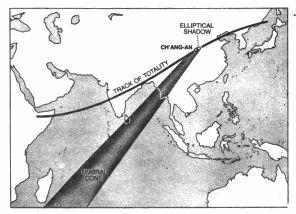
TOTAL SOLAR ECLIPSE was noted by the court astronomers at
Ch'ang-an (modern Slan), then the capital of China's Western Han dynasty,
on March 4, 181. b.c. This observation te evidence that the earth's speed
of rotation Is gradually diminishing. Unless allowance is made for the
resulting increase in the length of the day, a plot ot this totality track
would not pass over Ch'ang-an, as the Chinese historical records prove
it did. Both the conical shape of the moon's shadow in space and the shadow's
elliptical shape on the earth's surface are exaggerated.
To return to the West, at least to Alexandria, Ptolemy's Almagest
records nine timed observations of lunar eclipses that were made by Greek
astronomers in two brief periods: between 200 and 140 b.c. and between
a.d. 125 and 136. With one exception the observers were at Alexandria.
Their records were in general fairly crude, with the time of day given
only to the nearest third of an hour or so, but taken as a set they constitute
a useful supplement to the timed Babylonian and untimed Chinese observations.
It is impossible to tell whether the nine observations were selected from
a larger body of data or if they were all Ptolemy could find.
We have to come forward to medieval times to encounter further astronomically
useful eclipse references, both from Europe and from the Arab dominions.
In Europe an increasing number of monastic centers kept chronicles of major
events, among them earthquakes, bright comets and eclipses of the sun and
the moon. As a result more records of total eclipses of the sun are found
in monastic chronicles than are found in all other sources before 1700
combined. As an example, the total solar eclipse of a.d. 1239 was noted
by eight separate monastic communities ranging from Spain to Yugoslavia.
As with the near-total solar eclipse of a.d. 120 seen in China, the
medieval record of a near-total eclipse can be of value. Here is the account
of one such observation, made on August 2, 1133, at Prague: "An eclipse
of the sun appeared in a wonderful manner; this defection gradually diminished
so much that a crown like a crescent moon proceeded to the south part,
which afterward turned round to the east, henceforth to the west. At length
it was transformed to its original state." The account is somewhat garbled,
but it seems clear that at no time was the sun completely covered.
Pew monastic chronicles later than a.d. 1300 have been issued in compilations;
the reason is they are too numerous for such publication to be practicable.
As a result these later potential sources of European eclipse observations
remain largely untapped.
In the Arab dominions scientific astronomy as we know it did not begin
until about 150 years after the birth of Islam. The first leader to actively
encourage astronomy was the caliph al-Mansur, who founded Baghdad in a.d.
762; indeed, the plans for the city were drawn up with the help of a Persian
astronomer. Islamic interest in astronomy became high in Baghdad and Cairo
and later at both extremes of the realm: Cor-dova in Spain and Samarkand
in central Asia. Two different types of observations have come down to
us from the Islamic world. On the one hand are carefully timed observations
of solar and lunar eclipses made by skilled astronomers in well-equipped
observatories. On the other are random sightings of near-total or total
solar eclipses, recorded by various writers in much the nontechnical style
of the European chronicles.
Numerous observatory sightings were made at Baghdad and Cairo between
a.d. 800 and 1000. They were first studied by the American astronomer Simon
Newcomb a century ago, and- two of them will suffice to give some sense
of the Arab astronomers' craft. In each case the altitude of the sun or
the moon pr a suitable bright star was measured to the nearest degree or
half degree at the beginning and end of the eclipse. Thus for the partial
solar eclipse of June 8, 978, observed at Cairo, the record reads: "Altitude
of the sun when the eclipse began to be sensible to the view, 56 degrees
approximately; altitude at the end, 26 degrees approximately." For a lunar
eclipse of September 14, 927, observed at Baghdad, the record reads: "Altitude
of Sirius at the beginning, 31 degrees in the east; revolution of the celestial
sphere, from sunset until the commencement of the eclipse, determined with
the astrolabe, about 148 degrees." It is of interest that the determination
of altitude rather than the direct measurement of time remained a European
astronomical practice in observing eclipses and other events throughout
most of the 17th century; the practice ended only when reliable clocks
became available.
Known Arabian sightings of near-total and total eclipses of the sun
are few. It is probably because the Arab chronicles, many of which exist
only as manuscripts, have not yet been systematically searched. A recent
study by Bernard R. Goldstein of the University of Pittsburgh has uncovered
a brief but precise account of an annular eclipse. The account was mentioned
in one of the treatises of the Arab astronomer al-Biruni and relates to
the eclipse of July 28,873, as seen at Nishapur in Persia. Al-Bi-runi's
entry states: "[The astronomer al-Iranshahri] recorded that the body of
the moon was in the middle of the body of the sun such that the light of
the remaining portion of the sun surrounded it uneclipsed; thus it is clear
that the apparent diameter of the sun exceeds that of the moon." The last
clause, an interpolation by al-Biruni, is of course wrong, but Tycho Brahe
later arrived at the same mistaken conclusion quite independently.
As these various examples, drawn from records over the past 2,500 years,
make clear, there is a rich store of both solar and lunar eclipse observations
that can be utilized in the study of the earth's rotational history. Nevertheless,
these data are far from ideal. For instance, there is a gap between a.d.
100 and 800 and little usable material between a.d. 1300 and 1600. Hence
it is not at present possible to trace a continuous history of the variations
in the rate of the earth's rotation. How much can be done?
To analyze an eclipse observation it is necessary to compute the celestial
coordinates of both the sun and the moon with high precision. With the
sun the computation presents little difficulty. Toward the end of the 19th
century Newcomb produced a detailed theory of the motions of the earth
and the other inner planets around the sun; his theory is still used in
computing the data in Astronomical Almanac and similar ephemerides.
When the apparent positions of the sun as seen from the earth, computed
from Newcomb's theory, are checked against the positions computed from
a dynamical, integrated ephemeris, they show' no significant differences
throughout the historical period.
With computing the celestial coordinates of the moon, however, there
are problems. Modern lunar theory, largely the work of Ernest W. Brown
of Yale University at the turn of the century, would be able to provide
a highly accurate lunar ephemeris for any day in the historical past if
only the moon's rate of recession from the earth could be determined precisely.
This may eventually be possible, but astronomers today are unable to
compute the coordinates of the moon 2,000 years ago to closer than a tenth
of a degree. That rather large uncertainty upsets calculations bearing
on the changing rate of the earth's rotation in the past. It does not,
however, prevent ancient eclipse data from yielding useful information.
Consider the single total solar eclipse noted in the Babylonian records:
the eclipse of 136 b.c. That is possibly the most reliable of all ancient
eclipse observations. Neglecting the moon uncertainty, how fast would an
ideal clock, started in 136 b.c., now be compared with an earth clock?
The clock error would be in the range of 3.13 to 3.38 hours; any value
outside that range would make the 136 b.c. eclipse only a partial one at
Babylon, which would contradict the historical record.
Taking all the ancient data as a group (mostly Babylonian observations
but including a much smaller number of Chinese ones), the average rate
of day lengthening since ancient times is 1.78 ±.11 milliseconds
per century. (The allowance for observational error is as small as ±
.02 millisecond per century.) When the medieval data are similarly grouped,
the average value since a,d. 1000 is significantly smaller: 1.45 ±
.1,5 milliseconds per century. These histeclures compare with the tidal result
of 2.51 milliseconds per century.
As tidal friction is slowing down the earth's spin other processes act
to speed it up. Sea level has an influence. Some scholars suggest that
the planet is contracting; others suggest that the core is expanding, because
of continued heating by the radioactive isotopes in it. Either process
would diminish the planet's moment of inertia, accelerating its rate of
rotation and thereby decreasing the length of the day. The average rate
of day lengthening since ancient times would have been even greater except
for this accelerating influence. Furthermore, the smaller average rate
of lengthening indicated by the medieval eclipse data is due to an approximate
doubling of the acceleration component in more recent centuries. Thus it
would seem that over a period of some thousands of years the acceleration
of the earth's spin has been rather variable.
In default of any other adequate explanation, the nontidal tendency
toward a shorter day length may be attributable to a gradual decrease in
the earth's moment of inertia, whether it is due to sea-level changes,
to the planet's shrinkage or to the redistribution of material in its interior.
To judge from the diminishing millisecond-per-century values for day length,
the rate of diminution in the moment of inertia in recent centuries is
about twice what it was in ancient times. Now, as simple a change as a
1.2-meter fall in the average sea level over the past 2,500 years could
have produced the earlier, lower rate of diminution. Better historical
sea-level data than those now available may eventually help to determine
the actual importance of the other proposed causes for the rate change.
In any event the data contained in eclipse observations of the past may
well make significant contributions to a solution of these classic problems
of geophysics.
I am thankful to Dmitry M. Shkrabo for the suggesting and scanning of this article.
However, if the author or the representatives of Sci.Am. will inform me about their displeasure
with this publication, I shall remove it immediately.
Return to "Fomenkology"














